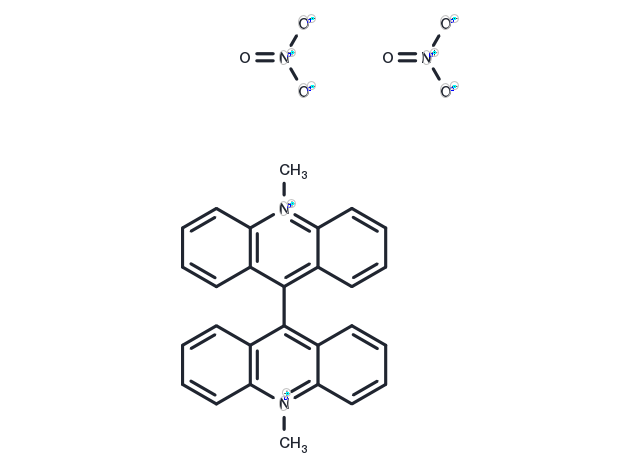keep away from direct sunlight
Powder: -20°C for 3 years | In solvent: -80°C for 1 year

Lucigenin (NSC-151912) (L-6868) is a chemiluminescent probe used to indicate the presence of endogenously generated superoxide anion radicals in cells.

| Pack Size | Availability | Price/USD | Quantity |
|---|---|---|---|
| 50 mg | In stock | $ 30.00 | |
| 1 mL * 10 mM (in DMSO) | In stock | $ 29.00 |

| Description | Lucigenin (NSC-151912) (L-6868) is a chemiluminescent probe used to indicate the presence of endogenously generated superoxide anion radicals in cells. |
| In vitro | Upon single-electron reduction of Lucigenin by a radical species the subsequent form of Lucigenin presents amplified chemiluminescence which is measurable and can be correlated to the respective amount of reactive radical species present in the system. In addition to indicating the presence of radicals in cells, Lucigenin shows interaction with redox-active oxidoreductase enzymes. Lucigenin is shown to mediate the reduction of cytochrome C by xanthine oxidase and to increase the rate of NADPH oxidation. |
| Synonyms | NSC-151912, L-6868 |
| Molecular Weight | 510.5 |
| Formula | C28H22N4O6 |
| CAS No. | 2315-97-1 |
keep away from direct sunlight
Powder: -20°C for 3 years | In solvent: -80°C for 1 year
DMSO: 80mg/mL (156.71 mM)
You can also refer to dose conversion for different animals. More
bottom
Please see Inhibitor Handling Instructions for more frequently ask questions. Topics include: how to prepare stock solutions, how to store products, and cautions on cell-based assays & animal experiments, etc.
Lucigenin 2315-97-1 Others NSC-151912 inhibit NSC 151912 L-6868 L 6868 NSC151912 Inhibitor L6868 inhibitor
